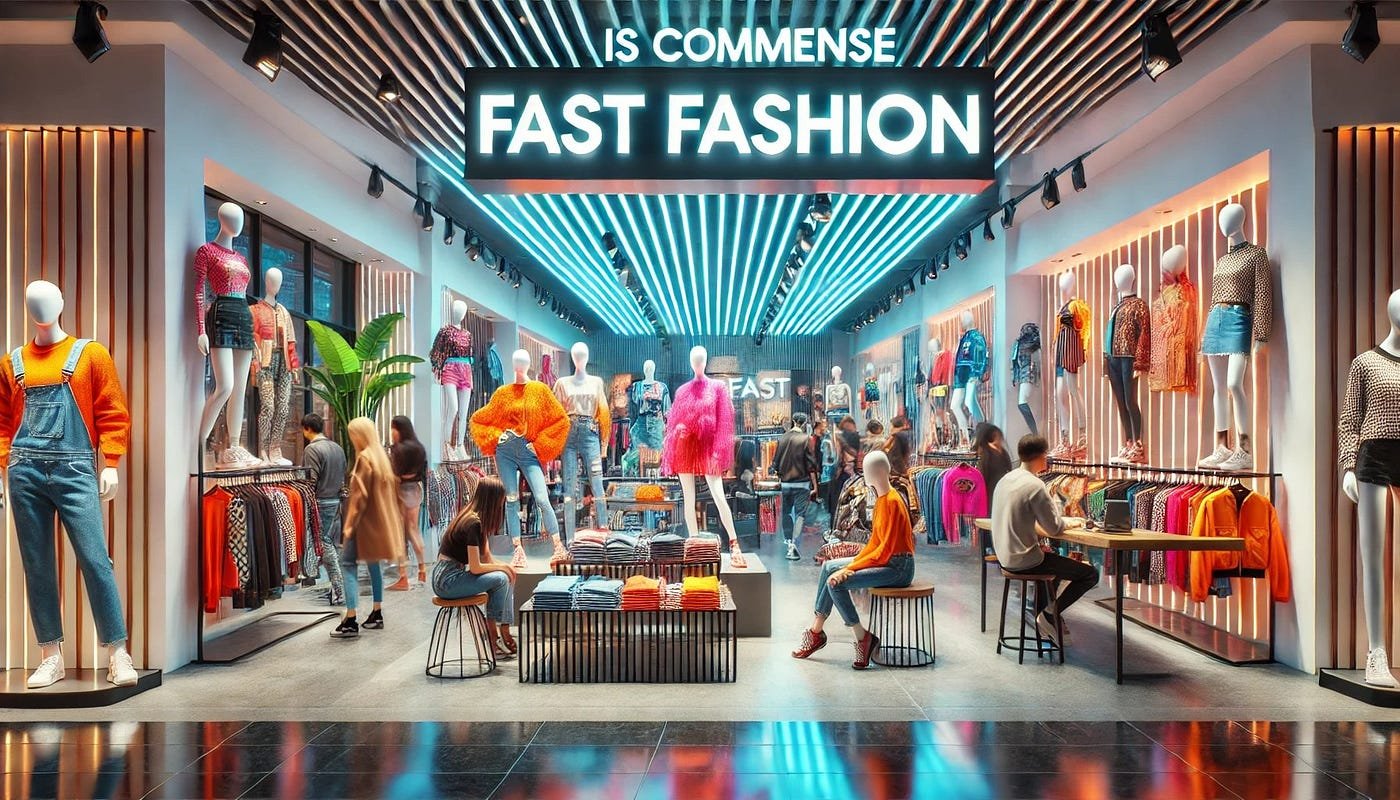Commense is considered a fast fashion brand. It offers trendy clothing at affordable prices with rapid production cycles.
Fast fashion has revolutionized the apparel industry by providing trendy, affordable clothing quickly. Commense stands out in this sector by delivering stylish pieces that cater to current fashion trends. This rapid production model allows consumers to access the latest designs at lower prices.
It emphasizes speed and cost-efficiency, making fashion accessible to a broader audience. However, this approach often raises concerns about sustainability and ethical practices. Many shoppers appreciate the variety and affordability Commense offers. Understanding its business model helps consumers make informed purchasing decisions.

Commense’s Production Practices
Understanding Commense’s production practices can help you make informed choices. Their production process impacts quality, sustainability, and ethics. Let’s explore the key aspects of their production practices.
Manufacturing Locations
Commense manufactures its clothing in various countries. These locations include China, India, and Bangladesh. Each location is chosen for specific reasons.
- China: Known for its large-scale production capacity.
- India: Renowned for textile craftsmanship.
- Bangladesh: Recognized for cost-effective labor.
These countries provide access to essential resources and skilled labor. This ensures that Commense can produce a wide range of styles quickly.
Labor Conditions
Labor conditions are a critical aspect of Commense’s production practices. Ensuring fair and safe working environments is essential. Commense claims to follow strict labor standards.
Here are some key points about their labor conditions:
- Workers receive a fair wage.
- Factories maintain safe working conditions.
- No child labor is involved in production.
Commense regularly audits its factories. This helps to maintain compliance with labor laws. Ensuring ethical labor practices is a priority for them.
In summary, Commense’s production practices focus on efficiency and ethics. Understanding these practices helps consumers make better choices.
Environmental Impact
Fast fashion is a major concern for the environment. The rapid production cycle leads to various environmental issues. One of the most pressing concerns is the depletion of natural resources. Let’s explore how fast fashion impacts the environment through Material Sourcing and Waste Management.
Material Sourcing
Fast fashion brands often use synthetic fibers like polyester. These materials are derived from non-renewable resources. The production process releases harmful chemicals into the environment. Natural fibers like cotton also have their issues. Cotton farming requires large amounts of water and pesticides. Both synthetic and natural fibers contribute to environmental degradation.
Here’s a table summarizing the impact of different materials:
| Material | Environmental Impact |
|---|---|
| Polyester | Non-renewable, chemical emissions |
| Cotton | High water use, pesticides |
| Rayon | Deforestation, chemical use |
Waste Management
Fast fashion results in a significant amount of waste. Clothes are often discarded after a few uses. This leads to overflowing landfills. Many of these garments are not biodegradable. They take years to decompose, releasing toxins into the soil and water.
Here are some staggering facts about fashion waste:
- 85% of textiles go to landfills each year.
- Clothes can take up to 200 years to decompose.
- Only 1% of clothing is recycled into new garments.
Effective waste management strategies are crucial. Brands need to adopt more sustainable practices. Consumers can also contribute by recycling and reusing clothes.
Quality Vs Quantity
Fast fashion is often criticized for prioritizing quantity over quality. Commense aims to change that perception. This section explores the balance between quality and quantity.
Durability Of Products
Commense focuses on the durability of their products. They use quality materials to ensure longevity. Fast fashion often means clothes wear out quickly. Commense aims to make clothes last longer.
A study showed that durable clothing reduces waste. This is essential for sustainability. Consumers benefit from longer-lasting clothes. It saves money in the long run.
Pricing Strategy
Commense uses a unique pricing strategy. They balance cost and quality. While prices may be higher, the value is evident. Consumers get better quality for their money.
Here’s a comparison table for better understanding:
| Brand | Average Price | Durability |
|---|---|---|
| Commense | $50 | High |
| Typical Fast Fashion | $30 | Low |

Consumer Perception
Consumers have mixed feelings about fast fashion brands. Commense is no different. Some shoppers appreciate the low prices and trendy styles. Others worry about the environmental and ethical impacts of fast fashion. Let’s dive deeper into what people think about Commense.
Brand Reputation
Commense has built a reputation for offering affordable, fashionable clothing. Some people believe the brand is reliable and trendy. Others argue that the quality may not be up to the mark. The brand’s focus on quick trends can lead to concerns about sustainability.
| Positive Aspects | Negative Aspects |
|---|---|
|
|
Customer Reviews
Customer reviews play a crucial role in shaping consumer perception. Shoppers often leave detailed feedback about their experiences. Reviews can highlight both the strengths and weaknesses of Commense.
Many customers praise the brand for its wide variety and trendy options. They enjoy the affordable prices and frequent sales. Some reviews mention that the clothing fits well and looks good.
On the flip side, some customers have complaints. Common issues include items not matching the pictures online. Others mention delayed shipping times and poor customer service.
Here are some common points from reviews:
- Positive Feedback:
- Trendy and stylish
- Affordable prices
- Frequent sales
- Negative Feedback:
- Quality does not match expectations
- Shipping delays
- Poor customer service
Ethical Considerations
Understanding the ethical considerations of fast fashion is crucial. Consumers today care about more than just style and price. They seek brands that align with their values. Here, we explore the ethical facets of Commense, focusing on animal welfare and fair trade practices.
Animal Welfare
Commense is under scrutiny for its use of animal products. This includes materials like leather and wool. Ethical brands avoid causing harm to animals. Commense claims to source materials responsibly. But how can we verify this?
It’s essential to check for certifications. Look for labels like “Cruelty-Free” or “PETA-Approved Vegan”. These certifications ensure no animal cruelty involved. Consumers should demand transparency. Commense should publish their animal welfare policies. This builds trust and accountability.
Fair Trade Practices
Fair trade ensures workers get fair wages and good working conditions. Fast fashion often exploits cheap labor. Commense needs to address this concern. Do they pay their workers fairly? Are the working conditions safe?
Certifications like “Fair Trade Certified” can help. They prove that the brand follows fair trade practices. Transparency in supply chains is vital. Consumers should ask for details about factories and labor conditions. Commense should disclose their supply chain information. This shows they value ethical practices.
Here’s a quick checklist for ethical shopping:
- Check for cruelty-free certifications.
- Look for fair trade labels.
- Demand transparency from brands.
Commense can improve its ethical stance. This will attract more conscious consumers. Ethical considerations are not just trends. They are essential values for the future of fashion.

Alternatives To Commense
Finding alternatives to Commense is a great choice for eco-conscious shoppers. Here are some ethical and sustainable options to consider.
Sustainable Fashion Brands
Choosing sustainable fashion brands helps reduce environmental impact. These brands use eco-friendly materials and ethical production methods.
| Brand | Key Features |
|---|---|
| Patagonia | Recycled materials, Fair Trade Certified |
| Everlane | Transparent pricing, Ethical factories |
| Reformation | Sustainable fabrics, Carbon-neutral |
| People Tree | Organic cotton, Fair Trade |
Second-hand Market
Buying second-hand clothes is another excellent alternative. It reduces waste and supports a circular economy.
- Thrift Stores: Local shops offer unique and affordable clothing items.
- Online Marketplaces: Websites like ThredUp and Poshmark offer vast selections.
- Vintage Shops: These stores specialize in high-quality, timeless pieces.
- Clothing Swaps: Community events where people exchange clothes they no longer need.
Both sustainable brands and the second-hand market offer stylish and ethical fashion choices.
Frequently Asked Questions
What Is Commense Known For?
Commense is known for its trendy, affordable clothing. It offers a wide range of styles, often inspired by current fashion trends.
Is Commense Considered Fast Fashion?
Yes, Commense is considered fast fashion. It focuses on quickly producing trendy, affordable clothing that appeals to a broad audience.
How Does Commense Keep Prices Low?
Commense keeps prices low through mass production and efficient supply chains. This allows them to offer trendy clothing at affordable prices.
Are Commense Clothes Sustainable?
Commense’s focus is on fast fashion, which is often criticized for being unsustainable. They prioritize speed and cost over eco-friendly practices.
Conclusion
Determining if Commense qualifies as fast fashion depends on various factors. Consider their production speed, pricing, and sustainability practices. Consumers should research and make informed choices. Supporting brands with ethical practices can drive positive change. Always stay informed and choose wisely to promote a more sustainable fashion industry.
